Marcia Thornton Jones's Blog, page 95
August 15, 2019
What The Dickens!
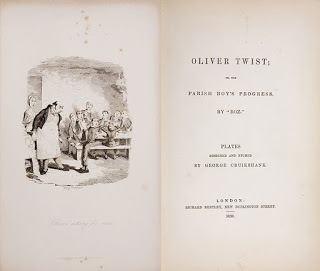 Frontispiece and title page, first edition 1838
Frontispiece and title page, first edition 1838Illustration and design by George CruikshankThis week I revisit an old theme. A long, long time ago, in a galaxy far far away, before the first Enterprise took flight, before the TARDIS was stolen, there lived a sickly child.
And, as it turns out, this sickly child read a lot and wrote a lot.
Way back then, I lived in the wild, wild west on the front range of Colorado. Colorado Springs was small then, full of open spaces. The public library was way, way on the other side of town. There were no bookstores. The only library available to me was my school library. I checked out every book I could read. By fourth grade, my favorite authors were already Mark Twain, Jack London, Tolkien’s The Hobbit. And if I wanted to have my very own copy of a book, so I didn’t have to return it, I copied the book.
One of the first and favorite books I copied was Oliver Twist, by Charles Dickens. You may remember, Charles Dickens wrote the story in part to expose the hypocrisy and cruel treatment of orphans in mid-19th century London. Dickens blended a grim realism with satire to describe the effects of industrialization, creating a story of an innocent child trapped in a life with no hope. What better story to entertain a sickly child!
He introduces his character by assigning an impersonal pronoun to the character, one without identity, calling the babe ‘it’, predicting its doom:
“For a long time after it was ushered into this world of sorrow and trouble, by the parish surgeon, it remained a matter of considerable doubt whether the child would survive to bear any name at all; in which case it is somewhat more than probable that these memoirs would never have appeared; or, if they had, that being comprised within a couple of pages, they would have possessed the inestimable merit of being the most concise and faithful specimen of biography, extant in the literature of any age or country…” - Charles Dickens, Oliver Twist
But the baby survived, earning the right to life as well as a name, Oliver:
“... There being nobody by, however, but a pauper old woman, who was rendered rather misty by an unwonted allowance of beer; and a parish surgeon who did such matters by contract; Oliver and Nature fought out the point between them. The result was, that, after a few struggles, Oliver breathed, sneezed, and proceeded to advertise to the inmates of the workhouse the fact of a new burden having been imposed upon the parish, by setting up as loud a cry as could reasonably have been expected from a male infant who had not been possessed of that very useful appendage, a voice, for a much longer space of time than three minutes and a quarter.” – Charles Dickens, Oliver Twist
Little did I know that it was a good thing, to write by hand. Scientists now know that cursive writing is an important tool for cognitive development. It teaches the brain to be efficient, helps to develop critical thinking skills and refines motor control. In fact, children who learn cursive tend to learn how to read faster, generate more ideas and retain more information. When I was copying Oliver Twist in the fourth grade, I paid more attention to the details of the story. I experienced the characters on a deeper level because the very act of writing them out engaged all my senses. I had to pay attention to the words, how they were ordered, and how they were used. And, of course, I experienced the linear logic of the plot.
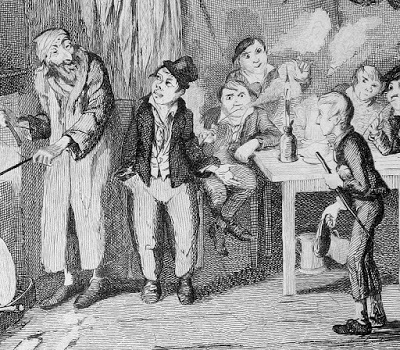 George Cruikshank original engraving of the Artful Dodger (centre), here introducing Oliver (right) to Fagin (left)
George Cruikshank original engraving of the Artful Dodger (centre), here introducing Oliver (right) to Fagin (left)One of my favorite characters in Oliver Twist was Jack Dawkins, otherwise known as the Artful Dodger. The snub-nosed, flat-browed, common faced pickpocket and leader of the gang of child criminals. He was not without heart, however.
It is the nature of reading that every story we’ve read stays with us, and its characters become a part of our lives. We are the product of all the stories read and lived. Even as we become characters in each other’s story. These stories settle within us, blend with our experiences – for why else could we become so attached to these characters, unless we see them as friends– and work their magic on us. They engage, and encourage, and guide.
And, when we least expect it, especially as one becomes a writer, such persistent characters ooze to the surface in some form found in our own works. Many light years down the road, when I read about the history of San Francisco, about the plight of the poor and that gallery of characters that walked those cobbled streets along the Barbary Coast, it was no accident that I envisioned Oliver Twist meets the wild, wild west.
My character became Jack London, in honor of my old friends, and not by coincidence:
“Jack of all trades, Lady Jane had called her. Pickpocket, escape artist, and a bold little rascal. A kid after her own heart, said Lady Jane. Lady Jane named Jack after one of her favorite towns, London. Jack London, that was her name. And this den was her home.
“She was by everyone’s accounts ordinary. Not small, not tall, not too thin. Not so clever as some but not near as dull as others. All except for her eyes. They were a pale, bright blue. They seemed like ghost eyes. Old sailors said she had the evil eye, saying she brought nothing but bad luck to everyone she knew. Get away with those buggery eyes, they warn her, or they’d take a switch to her backside.
“Despite being so common, she carried herself with the dash of one standing six feet tall. She wore a man’s coat over her tattered dress, one that nearly touched her boot heels. She had turned the cuffs back so she could use her hands, and stuff them comfortably into the large pockets.”
Still a work in progress, Jack London has yet to find a home. As she skips away, down the road, tipping her bowler, she sings out to me, “ Once a villain, you’re a villain to the end!”
And I call out: “And you, Jack London, you’re my friend! To the end!”
What favorite reads did you have as a child? How did they influence your life?
-- Bobbi Miller
Published on August 15, 2019 04:29
August 13, 2019
INTROVERTS UNITE (QUIETLY, AND IN YOUR OWN WAY)! By Chris Tebbetts
NOTE: I'm going off-topic this month and putting up an entry that originally appeared on the SCBWI blog last month. It evoked more response than anything I've ever posted, so I thought it might be worth sharing here as well. Enjoy!
Since 2001, when I took my first kidlit writing class with Barbara Seuling (who a lot of SCBWI folks will remember as fondly as I do), I’ve worked on thirty published novels. Of those thirty, twenty-nine have been ghostwritten, work-for-hire, or co-authored.
Which is also to say that twenty-nine of my thirty published books have someone else’s name, and not mine, on the copyright page. But more about that in a minute.
I didn’t set out to become a professional co-author. It just kind of happened that way, through a series of unforeseen opportunities and coincidences. It turns out, though, that I like it. A lot. I like how it’s allowed me to write full time. I like the creative synthesis of working with other storytellers. And I really like having high-profile partners who take care of the marketing and promotion end of things. For a prototypically introverted writer like me, that’s no small thing.
All of this has afforded me some experiences that go way beyond the hopeful imaginings of my eighteen-years-ago self. The MIDDLE SCHOOL books I’ve written with James Patterson have sold millions of copies and been made into a movie. I also got to write two trilogies with Jeff Probst, the host of my honest-to-god favorite t.v. show of all time.
So yeah, no complaints.
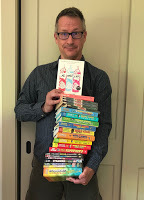
But what I’ve never done—until now—is publish a book in the usual way: written on spec, sold through my agent, and with full ownership of the copyright at the end of the day.
That new book is a YA novel called ME, MYSELF, AND HIM, out July 9. It’s a “Sliding Doors” story with parallel narratives that follow my 18-year-old protagonist through two different outcomes from the same inciting incident (an autobiographically drawn episode in which my character breaks his nose huffing whippets behind the ice cream store where he works). The story is one part memoir, a lot of parts fiction, and also the most personal thing I’ve ever written, by far.
That seems appropriate, too, since this is the first time I’m stepping out as a solo act, and, by extension, as the person in charge of selling my own work to its prospective audience. It’s been a whole new experience with a steep learning curve—not just about the business end of publishing, but also in terms of the emotional rigors of doing such a thing.
There’s a kind of cruel joke in the world of publishing. This is an industry that attracts some large number of people (like me) who thrive on working in quiet isolation, only to then ask them to turn around and shout “LOOK AT ME!” in the most convincing voice possible when it comes time to share that same work with the world. It tends to bring up an insecurity or two. Or three.
I’ve never needed skin so thick before. Never grappled with the kind of loin-girding that this level of self-promotion requires. And what’s more, I find myself feeling envious of other writers in a whole new way. I obsess about the things my publisher is (and isn’t) doing to promote the book. And I’m constantly measuring my own highs and lows against whatever it is my colleagues seem to be experiencing with their own 2019 releases. (Emphasis on the seems to be, given the slanted reality that is other peoples’ lives on social media.)
Should I even be admitting all of this publicly? Maybe not. As I said, I’m learning as I go. But I also know that talking about it has helped as much as anything. Naming these things out loud has been pretty good at taking away some of their power. It’s also come to show me how much I’m not alone in all of this anxiety.
The more I talk with other authors about this subject—the nasty grip of social anxiety in the face of self-promotion; the impossible odds of breaking through the white noise; the “who am I?” sting of impostor syndrome—the more I realize that it’s one of the most common themes in the lives of writers. None of that awareness takes away the stress, per se, but there is certainly something to be gained from recognizing it as a shared experience. (And tangentially, let me recommend this article from the Guardian, “Everyone is totally just winging it, all the time.” https://www.theguardian.com/news/oliver-burkeman-s-blog/2014/may/21/everyone-is-totally-just-winging-it)
The good news is, we’re in the business of shining lights into dark places. We have a unique obligation to our audience, to offer some hope where it’s needed, and to show our readers how very much not alone they actually are. And that extends to the way we treat each other as well. My non-writer friends are always commenting to me about how cool it is to see all of my kidlit people on social media, cheering each other on, promoting one another’s work, and generally making this a wonderful industry to be a part of.
So, even as I’ve dipped my toe into these new waters, and even as I’ve found it to be distressingly chilly at times, I’ve also come to realize that if I raise my head and look around once in a while, I’ll find that I’m not swimming alone.
Not even close.
Published on August 13, 2019 03:53
August 12, 2019
Traveling Through Our Books
Writing fiction is a form of time travel. Science fiction takes us into the future, and historical fiction gives us a ride into the past. Even if a story is set in the present, we have to provide enough detail to make the reader feel like she is a witness to what is taking place.
There is a reason why many beloved books have stood the test of time. The authors of books like the Little House Series, Chronicles of Narnia,

Island of the Blue Dolphins, and A Wrinkle in Time create realistic worlds that we want to visit again and again. When the setting, characters, and unique details are painted with words, we lose all track of time and want to stay in this place.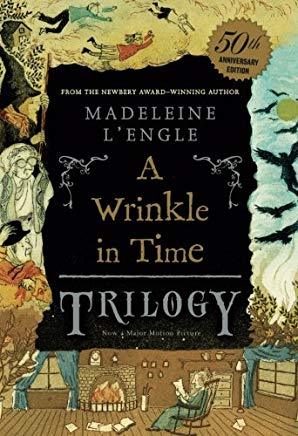
As a writer of historical fiction, research is what brings a time period to life.
If I want readers of my novel WHEELS OF CHANGE to follow Emily Soper’s adventures, they have to be grounded in the reality of 1908 Washington DC.
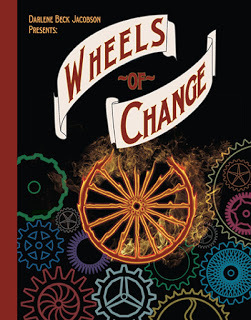
What was life like in the Nation’s Capital 110 years ago?
It was very rural for one thing. With the exception of Pennsylvania Avenue, the area around the train station, and a few streets bordering 7th Street – the main street of commerce - there was only gas lighting and no electricity. Indoor plumbing was still a novelty. Many roads were unpaved or had cobblestones. There were farms and wooded areas surrounding the government buildings. Most people still rode in horse-drawn wagons, carriages, or buggies. Many goods were still made by hand. Incorporating these details into the story grounds it and fixes the time and place.
Characteris another way to create an authentic story. When a story takes place in another era, the writer has to be sure to use language and sentence structure that rings true. In 1908, children spoke in a more formal style, like their parents. Very little slang was used. Children addressed other adults as Mr. or Mrs. and often used “sir” or ‘ma’am” when speaking to their parents.
A character’s actions and behavior was different than it is today. Expectations for males and females were much more divided and specific. Boys had more freedom to explore and be adventurous. They were expected to roughhouse and get into trouble now and then. Girls on the other hand, were expected to be lady-like and exhibit proper behavior at all times. They were encouraged to excel at the “domestic arts” such as sewing, cooking, housekeeping, and child rearing.
The best books transport us and make us feel we are right beside the characters. Finding the right details takes us there.
There is a reason why many beloved books have stood the test of time. The authors of books like the Little House Series, Chronicles of Narnia,

Island of the Blue Dolphins, and A Wrinkle in Time create realistic worlds that we want to visit again and again. When the setting, characters, and unique details are painted with words, we lose all track of time and want to stay in this place.

As a writer of historical fiction, research is what brings a time period to life.
If I want readers of my novel WHEELS OF CHANGE to follow Emily Soper’s adventures, they have to be grounded in the reality of 1908 Washington DC.

What was life like in the Nation’s Capital 110 years ago?
It was very rural for one thing. With the exception of Pennsylvania Avenue, the area around the train station, and a few streets bordering 7th Street – the main street of commerce - there was only gas lighting and no electricity. Indoor plumbing was still a novelty. Many roads were unpaved or had cobblestones. There were farms and wooded areas surrounding the government buildings. Most people still rode in horse-drawn wagons, carriages, or buggies. Many goods were still made by hand. Incorporating these details into the story grounds it and fixes the time and place.
Characteris another way to create an authentic story. When a story takes place in another era, the writer has to be sure to use language and sentence structure that rings true. In 1908, children spoke in a more formal style, like their parents. Very little slang was used. Children addressed other adults as Mr. or Mrs. and often used “sir” or ‘ma’am” when speaking to their parents.
A character’s actions and behavior was different than it is today. Expectations for males and females were much more divided and specific. Boys had more freedom to explore and be adventurous. They were expected to roughhouse and get into trouble now and then. Girls on the other hand, were expected to be lady-like and exhibit proper behavior at all times. They were encouraged to excel at the “domestic arts” such as sewing, cooking, housekeeping, and child rearing.
The best books transport us and make us feel we are right beside the characters. Finding the right details takes us there.
Published on August 12, 2019 06:00
August 11, 2019
Travel and Story: A Tale
 by Jody FeldmanOnce upon a time, there was a book idea that lived in and around the Port of Los Angeles. Sure, the story could have happened in Newport or New Orleans or New York, but the story’s spark ignited in LA.
by Jody FeldmanOnce upon a time, there was a book idea that lived in and around the Port of Los Angeles. Sure, the story could have happened in Newport or New Orleans or New York, but the story’s spark ignited in LA.In its infancy, the story traveled down the usual roads, anchored in character and theme and plot, but when it came to setting, it begged to be on the West Coast. The problem was, the author lived smack dab in the middle (phrase intended) of the United States.
How would the author make it real? How could she convince readers they were actually walking among the characters in the sun and the sea and salt air? How could she add those small, but vital impressions without soaking them in herself?
If only she’d known that her visit would spark a story, she would have taken pictures. She would have been more aware of her surroundings. She would have breathed in the smallest of details.
Instead, she did what could. She relied on her general memories. She relied on people who did live there, friends and family and strangers. She relied on Google Maps, and the ability to walk down streets, virtually. True, she couldn’t hear the sounds or feel the air or smell the smells herself as she wrote the scenes. She could only hope that she’d get every detail right.
That was truly important to her. She once saw a movie, set in her hometown, that got several details so flagrantly wrong, she couldn’t enjoy the story. If only the (much-heralded) director had done a little homework!
Aha! The author needed to do her homework! One day, preparation met opportunity. She smelled the smells, breathed in the vibes, walked the paths.
And now, she can begin to hope that the story will live happily ever after.
Published on August 11, 2019 04:00
August 8, 2019
Traveling Through Our Books -- by Jane Kelley
I've just returned from a trip to the moon.

Or as close as one can get to it on earth. My family and I visited the Craters of the Moon -- a National Monument in Idaho. The lava field is so rugged that NASA actually used it to prepare astronauts Alan Shepard, Edgar Mitchell, Eugene Cernan, and Joe Engle for their mission to the moon that's 239 thousand miles away.
The landscape was beautiful. Spatter cones were as intricately carved as any work of art. The geology was fascinating. The lava under our feet had oozed up from a great rift and was over a mile deep. In many places, caves had formed as lava continued to flow beneath the rapidly cooling surface. I loved being there. It sparked my imagination in a multitude of ways. These are probably the only words I will ever write about it.
Why?
I have great admiration for writers who can transport me to a brand new world. That is one of joys of reading. I've tried sometimes to do that, but I always find myself returning to the landscapes I know. The woods. Manhattan. Rural suburbs of Wisconsin. Brooklyn. Often it's a specific spot. For instance, my parrot Zeno perched on an actual statue of an angel at Greenwood Cemetery -- which he, in his arrogance, believed was a Parrot-Man.

How did I think of that? Well, I spent a lot of time wandering around that cemetery. It helps me to know a place. To be familiar with everything about it. To be a resident and not a tourist.
And yet I know I travel when I write my stories. I try to visit an emotional geography--like the foot of this immense mountain of cinders that erupted from deep within the earth.
 And there, despite howling winds, the blazing heat of the sun, and an uncertain water supply, I discover that some flowers can still bloom.
And there, despite howling winds, the blazing heat of the sun, and an uncertain water supply, I discover that some flowers can still bloom.
Published on August 08, 2019 03:00
August 3, 2019
Celebrate International Peace Month with YPPL Naomi Shihab Nye
 By AdiJapan - Own work,
By AdiJapan - Own work, CC BY-SA 3.0,
https://commons.wikimedia.org/
w/index.php?curid=535694I was pretty excited when I heard Naomi Shibab Nye had been selected to serve as Young People's Poet Laureate. And I can't think of a better way to celebrate International Peace Month than with some of her poetry! So, I'd like to direct you to a recent Poetry Friday Roundup that had poets sharing all things Naomi... spend some time digging into these posts, and I guarantee you'll feel better about the world.
Some quotes I recorded in my notebook:
"Poetry allows us to cherish what we've been given." - Naomi Shihab Nye
"Poetry opens us to life, to surprise, to shadow, to beauty, to insight." - Naomi Shihab Nye
"There's no place that poetry doesn't live." - Naomi Shihab Nye
Go forth and find a poem today!
------
Irene Latham lives on a lake in rural Alabama. Winner of the 2016 ILA Lee Bennett Hopkins Promising Poet Award, she is the author of hundreds of poems and nearly twenty current and forthcoming poetry, fiction and picture books from publishers including Penguin Random House, Macmillan, Lerner, Boyds Mills, and Charlesbridge. Her books have been recognized on state lists and honored by NEA, ALA, NCTE, SIBA, Bank Street College and other organizations.
Published on August 03, 2019 03:30
July 29, 2019
Give Me One With Everything, But Hold the Ketchup
By Charlotte Bennardo

Hot dogs are like books. Some are basic, like Ernest Hemingway's novel Old Man and the Sea. For purists, the simple language allows them to appreciate the story and literary nuances. A plain hot dog allows one to taste the spices of the juicy meat, appreciate the delicate texture of the roll, and with one condiment like mustard or ketchup, get a little flair. Many people like their books like their hot dogs- don't mess with perfection by overloading.
Others are more demanding. Like the person that loads on onions, mustard, relish, and sauerkraut, or chili, beans, hot sauce, and peppers, the more, the better. With writers like George R. R. Martin and Game of Thrones, the adjectives and descriptive language are piled on. For some, it's too overpowering, but for others, the long parade of varying flavors and textures simply delights.
Like many, I'm in the middle. I love my hot dogs with spicy brown mustard and relish. I have to put mustard under the dog, then on top, then relish, which has excess water drained out so the roll doesn't get soggy. I'm particular about what I read too. I like what I like, and don't want to mess with perfection. Books that I like have description, but more action that adjectives. I like a little backstory, but am not too fond of extensive flashbacks. Bare bones language books tend to bore me because I need a little kick. I need a balance of bones and extras.
Enjoy your hot dogs and your books- however you like them!

Hot dogs are like books. Some are basic, like Ernest Hemingway's novel Old Man and the Sea. For purists, the simple language allows them to appreciate the story and literary nuances. A plain hot dog allows one to taste the spices of the juicy meat, appreciate the delicate texture of the roll, and with one condiment like mustard or ketchup, get a little flair. Many people like their books like their hot dogs- don't mess with perfection by overloading.
Others are more demanding. Like the person that loads on onions, mustard, relish, and sauerkraut, or chili, beans, hot sauce, and peppers, the more, the better. With writers like George R. R. Martin and Game of Thrones, the adjectives and descriptive language are piled on. For some, it's too overpowering, but for others, the long parade of varying flavors and textures simply delights.
Like many, I'm in the middle. I love my hot dogs with spicy brown mustard and relish. I have to put mustard under the dog, then on top, then relish, which has excess water drained out so the roll doesn't get soggy. I'm particular about what I read too. I like what I like, and don't want to mess with perfection. Books that I like have description, but more action that adjectives. I like a little backstory, but am not too fond of extensive flashbacks. Bare bones language books tend to bore me because I need a little kick. I need a balance of bones and extras.
Enjoy your hot dogs and your books- however you like them!
Published on July 29, 2019 07:41
July 24, 2019
I Only Want a Hot Dog (Are You Sure?)
I’ll be honest: I’ve been struggling about what to write on the topics of hot dogs or niche marketing. I don’t know much about either. I wasn’t sure I could generate enough enthusiasm for either topic.
But today when I saw this t-shirt advertised, I knew what I could get excited about…and that’s the abuse of the poor little four-letter word “only.”

If we want to communicate effectively, we must know our syntax. Every time I teach a writing class, I go on a rant about “only” and how everyone seems to have forgotten where to put it.
I saw an ad for cable TV the other day, saying, “Only pay for the channels you want.”
If they offer you fries with your hot dog and you don’t want fries, most of us will say, “I only want a hot dog.”
And the t-shirt in the above photo? That poor dog!
No, no, and no.
Pay ONLY for the channels you want. You want ONLY a hot dog. And don’t you think that in addition to talking to your dog today, you should also feed him and play with him? You’re only talking to him?
And with apologies to Stevie Nicks, let me point out that thunder happens ONLY when it's raining.
“Only” should go next to (or as closely as possible to) the word or phrase it modifies.
Would I break this rule if my character is a child or a regular Joe who talks like most of the population? Absolutely. Otherwise, as the great James J. Kilpatrick, my hero and author of TheWriter’s Art , would say…
If your only’s lonely, move it!
Ginger Rue is the author of the Aleca Zamm series from Aladdin and the Tig Ripley series from Sleeping Bear.
Published on July 24, 2019 02:49
July 22, 2019
Maybe Goldilocks Doesn’t Need a Chair At All: Smack Dab in the Imagination by Dia Calhoun
Whenever I’m stuck making an either/or creative choice—I know my imagination is on vacation. Imagination is a land of both/and.Don’t get me wrong. Either/or does have its place. But it’s not always generative and often negative because it doesn’t allow for possibility.
The struggle to hold a both/and place, at least for a while, often allows a third thing—a new solution—to arise. This is hard to do, of course. We want to know the answer and want to know it now. Rational brain is a necessity for writers, but relied on too much, it can limit options.
Both/and is not a simple formulation such as: this chair is too soft, this chair is too hard, so this chair in the middle must be just right. In a choice between a hard chair and a soft chair, the solution might not be a chair at all. It might be a swing. A hammock. A hot air balloon. The writer must allow herself to dwell in the discomfort of not knowing in order to give imagination time to create that third thing. I call this creative drift.
Trust process. In your creative life, make process goals like time for creative drift as important as outcome goals (generating a certain number of words or pages). If you do, your work will be easier in the long run, better, and much more imaginative.
Published on July 22, 2019 22:00
July 20, 2019
Ketchup Please!
Anyone who lives in Chicago, as I do, knows you’re not supposed to squeeze one of kids’ favorite condiments on your hotdog. Once past a certain age, putting ketchup on a Chicago dog, as some people call them, is kind of like sacrilege. But, whether I’m getting one of these Chicago favorites from one of my Chicago favorites like Portillo’s or Buona Beef, I still love to drench my dog in ketchup. What can I say? Maybe I’m only grown up on the outside. Even so, alongside my ketchup, I do enjoy some “grown-up” things on my hotdogs too, like cucumbers, pickles, tomatoes, and celery salt, but what I don’t love is what most might say is a hotdog necessity – mustard. I just don’t like the stuff. On hotdogs. On sandwiches. Even on big salty pretzels.
Maybe you’re wondering, even during National Hotdog Month, what my love of ketchup on hotdogs has to do with anything. For National Hotdog Month, I decided I’d use the example of my personal preference when it comes to my hotdog condiment choice to say a few words about character. Many writers fall in love with a story they want to tell because of a character. Many readers fall in love with a book they read because of a character. But what does that have to do with hotdogs and ketchup? More than you might think.
It’s the myriad of tiny details about a person that make them who they are – their likes, their dislikes, their opinions, their strengths, their weaknesses, their faults, and so on. By themselves, each detail may not seem to be important, but when authors intentionally put specific details together, they create a character, and some might argue, even breathe life into that character. Maybe a character to love; maybe one to hate; but regardless, if an author does it well, the characters they create will evoke emotion of some kind in their reader.
So, whether I like ketchup or mustard on my hotdog, doesn’t make much difference, but what the characters we read and write about like, and dislike, makes all the difference in the world because it’s those details that tell us who they are. And, once we know enough about them, whether we hate them or love them, they become real to us, giving them the power to tell us their stories. The very stories they’ve inspired their authors to tell.
Happy Reading & Writing,
Nancy
Published on July 20, 2019 04:30



